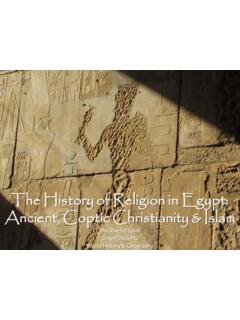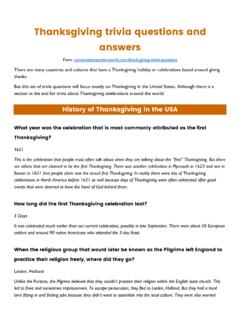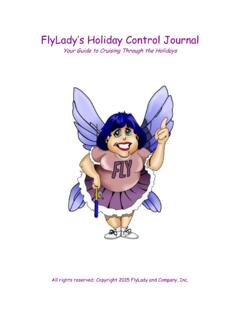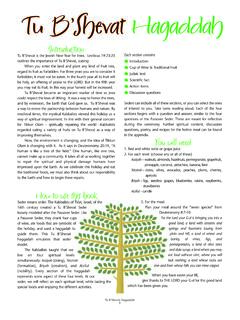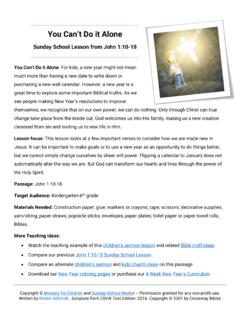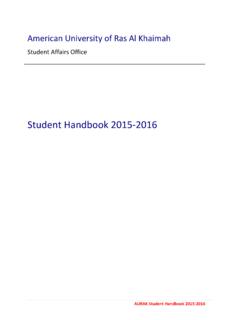Transcription of The Berbers of Morocco - University of Arizona
1 The Culture and Arts of Morocco and the BerbersMoroccoLocation:Northwest Africa, on Atlantic oceanPart of the Maghreb -the name for the alliance of North African countries -Algeria,Tunisia, Libya, Mauritania Population:33 million. Area:Slightly larger than CaliforniaLanguage:Official written language, (not spoken): Classical ArabicUsed for official government documents & business: French Common spoken language: Moroccan Arabic (not written)Common spoken & written: Berber (called Tamazight) Political System:Constitutional Monarchy with a Legislative & Judicial branch. King Mohammad VI is the head of state and spiritual leader and appoints the primeminister. Morocco gained independence from France in 1956. Controversy:The southern region of Morocco , aka Western Sahara has been a disputed territory since 1991.
2 Western Saharan people (Sahrawis) would like to establish their own country. Currently 200,000 are refugees in Algeria. The proposed that be a domestic autonomous region like Tibet. No :Newsweekmagazine, August 2010, listed Morocco 6th in the world amongst smaller population countries in economic development for such sectors as: services such as tourism, telecom and textiles, mining ( world 's third-largest producer of phosphorus), fishing, salt, construction, manufacturing. Still dependent too much on agriculture which employs about 45% of the population. The King has been instrumental in developing the economy and owns many businesses. When the King proposed building more dams Moroccans engaged in farming went from 70% to 45%.
3 Alfalfa, tomatoes, wheat are large king of Morocco , Muhammad VI, is unique among all rulers in the Islamic world as he bears the title Commander of the Faithful. Below, the King at Throne Day on July 31st, the anniversary of his coronation, a national :99% Muslim (mostly Sunni moderates, Sufis, and some Shi ah). A large Jewish community lived in Morocco before the creation of Israel, numbering approximately 265,000 in 1948. Between 7,000 and live there now. Ethnic Berber & ethnic Arabs, .7% Other (Christian), .2% Jewish Climate:Mediterranean which means rain in the winter and dry in the summer. Morocco is an Arid environment on the edge of the Sahara desert (which is mostly rock with only some sand dunes). There are extensive rivers on the Western Plains where they get 15 -20 rain a year.
4 On the eastern side of the country they receive 2 -3 rainfall (a drought and salt in the water in the south are problems). In the extremely dry areas farming takes placein the oases areas called Palmeraie s (linear oases) often with ancient systems of irrigation (see photo to right).Their architecture is considered Africanatebecause of it s thick-walled adobe clay buildings similar to those found in much of women:They have more rights than many other Arab countries due to the Kings support many now are judges, scholars, and teach/support other women to grow. Not all women cover up with the traditional Hijab headscarf Morocco is considered to be a moderateIslamic s Coast & , Meknes and Middle Atlantic Atlantic and High Valleys and MoroccoEducation Education is a high priority no in the country.
5 Since 1999 a new program was instituted by the government called Decade of Excellence to teach the importance of changing Morocco through education and to reform the education system to include preschool education. The government is also trying to introduce the American system of education. Preschool-children go to koranic schools where they learn Arabic. Primary school 6 12 years (Muslim children read Koran, Jewish read the Torah). Many children leave school at 12 years old to help their parents farm. Secondary school 13 15 years called Idadiya High school(16-18) called Taniwiya History & Geography taught in Arabic Math & Social Sciences taught in French University taught only in French (so you must read, write and speak French!)
6 The Berbers The name Berberis a variation of the Latin original word Barbarian , earlier in history applied by the Romans specifically to their northern hostile neighbors from Germania. The Barbary coast, on the coast of northwest Africa was named after the Berbers because they and Arabs pirated ships going to the Mediterranean Sea. The Berbers call themselves "Imazighen", meaning the are non-Arabic tribes that are often referred to as Arab-Islamic. Over the last several hundred years many Berber peoples have converted to Islam. History: The Berbers are known to have been in North Africa at least in 3000 They are thought to have come across northern Africa. Many early Roman, Greek, and Phoenician colonial accounts mention a group of people collectively known as Berbers living in northern Africa.
7 Other waves of Berber immigration came in the 3rdand 11thcenturies. Some Berbers trace their lineage to Yemen. Population: Morocco has the majority of Berbers , million (40% of the population). These can be divided into three main groups with different dialects: the Riffians, the Chleuh and the Central Moroccan Amazigh. They are also in neighboring Saharan countries: Algeria, Tunisia, Libya, and Egypt, with mainly Tuareg Berbers living in Mauretania, Niger, Mali, and Burkina-Fasso. Two-thirds of Berbers live in rural and mountainous areas, most being farmers. Prior to independence in 1956, half of Morocco were Berbers . After this Arabic became the main language and an Arabization period began (government-initiated agenda to counter French colonial values).
8 Housingis clay, adobe, stone and/or brick, and for nomadic Berbers , tents made out of wool and goat hair. Often the extended family will have a few dwellings on a property with a wall around them (also called a compound) so that they have an area to garden, keep goats, etc. But more families live in separate housing more than ever before. Many people dress in Berber style blue robes. These are carpet sellers in Ourzazate, in the heart of Morocco & Berber territory. Morocco s mixture of races and culture includes Berbers intermarrying with Arabs and other Africa tribal artist who also runs a Jewish artifact museum in Berber encampment from high on a sand dune. A Berber Toy TentEconomyBerbers are often portrayed as nomadic people crossing the desert on camels, but most are farmers in the mountains and valleys throughout northern Africa.
9 Some do trade throughout the region. Historically Berber merchants were responsible for transporting goods by camel caravans. There were basically five Trans-Saharan trade routes which extended across the Sahara from the northern Mediterranean coast of Africa to the great cities, which are situated on the southern edge of the Sahara, such as Timbouctou in Mali. From there the goods were distributed throughout the world . Traditionally, Berbers raise sheep, cattle and goats. Some Berbers work in flourmills, do woodcarving, quarry millstones, and make pottery or jewelry. Women generally do the cooking and caring for the home and children, weaving, and pottery. Today, many Berbers work in Spain or France as migrant workers and send money home to their Berbers were originally Nomadic (moving their home and not staying in one place to graze their sheep and goats and take advantage of better weather, living in tents as here).
10 These Berber families move to summer and winter climates that benefit their families and goats & Berber woman on a windy day in her summer home. We snapped this from the road with a long SystemsBerber society is made up of families who are members of a tribe which is a member of a clan of tribes. Each tribe has a chieftain. The French had the tribes organized into confederations to control them. After independence the King created 16 regions of Morocco based around geographic Berbers were farmers. At one time, tilling the land was considered the work of the lower classes, while the upper classes were merchants. Usually, groups of sedentary Berbers paid allegiance to a locally appointed headman, who in turn reported to the noble who considered the village his domain.


